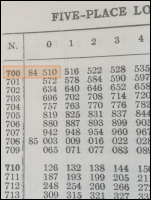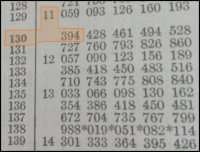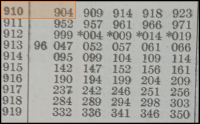Mark Dominus (陶敏修)
mjd@pobox.com

Archive:
| 2024: | JFMA |
| 2023: | JFMAMJ |
| JASOND | |
| 2022: | JFMAMJ |
| JASOND | |
| 2021: | JFMAMJ |
| JASOND | |
| 2020: | JFMAMJ |
| JASOND | |
| 2019: | JFMAMJ |
| JASOND | |
| 2018: | JFMAMJ |
| JASOND | |
| 2017: | JFMAMJ |
| JASOND | |
| 2016: | JFMAMJ |
| JASOND | |
| 2015: | JFMAMJ |
| JASOND | |
| 2014: | JFMAMJ |
| JASOND | |
| 2013: | JFMAMJ |
| JASOND | |
| 2012: | JFMAMJ |
| JASOND | |
| 2011: | JFMAMJ |
| JASOND | |
| 2010: | JFMAMJ |
| JASOND | |
| 2009: | JFMAMJ |
| JASOND | |
| 2008: | JFMAMJ |
| JASOND | |
| 2007: | JFMAMJ |
| JASOND | |
| 2006: | JFMAMJ |
| JASOND | |
| 2005: | OND |
Subtopics:
| Mathematics | 238 |
| Programming | 99 |
| Language | 92 |
| Miscellaneous | 67 |
| Book | 49 |
| Tech | 48 |
| Etymology | 34 |
| Haskell | 33 |
| Oops | 30 |
| Unix | 27 |
| Cosmic Call | 25 |
| Math SE | 23 |
| Physics | 21 |
| Law | 21 |
| Perl | 17 |
| Biology | 15 |
Comments disabled
Sun, 15 Oct 2023
[ Addendum 20231020: This came out way longer than it needed to be, so I took another shot at it, and wrote a much simpler explanation of the same thing that is only one-third as long. ]
A couple days ago I discussed the weird little algorithm of Percy Ludgate's, for doing single-digit multiplication using a single addition and three scalar table lookups. In Ludgate's algorithm, there were two tables, !!T_1!! and !!T_2!!, satisfying the following properties:
$$ \begin{align} T_2(T_1(n)) & = n \tag{$\color{darkgreen}{\spadesuit}$} \\ T_2(T_1(a) + T_1(b)) & = ab. \tag{$\color{purple}{\clubsuit}$} \end{align} $$
This has been called the “Irish logarithm” method because of its resemblance to ordinary logarithms. Normally in doing logarithms we have a magic logarithm function !!\ell!! with these properties:
$$ \begin{align} \ell^{-1}(\ell(n)) & = n \tag{$\color{darkgreen}{\spadesuit}$} \\ \ell^{-1}(\ell(a) + \ell(b)) & = ab. \tag{$\color{purple}{\clubsuit}$} \end{align} $$
(The usual notation for !!\ell(x)!! is of course “!!\log x!!” or “!!\ln x!!” or something of that sort, and !!\ell^{-1}(x)!! is usually written !!e^x!! or !!10^x!!.)
The properties of Ludgate's !!T_1!! and !!T_2!! are formally identical, with !!T_1!! playing the role of the logarithm function !!\ell!! and !!T_2!! playing the role of its inverse !!\ell^{-1}!!. Ludgate's versions are highly restricted, to reduce the computation to something simple enough that it can be implemented with brass gears.
Both !!T_1!! and !!T_2!! map positive integers to positive integers, and can be implemented with finite lookup tables. The ordinary logarithm does more, but is technically much more difficult. With the ordinary logarithm you are not limited to multiplying single digit integers, as with Ludgate's weird little algorithm. You can multiply any two real numbers, and the multiplication still requires only one addition and three table lookups. But the cost is huge! The tables are much larger and more complex, and to use them effectively you have to deal with fractional numbers, perform table interpolation, and worry about error accumulation.
It's tempting at this point to start explaining the history and use of logarithm tables, slide rules, and so on, but this article has already been delayed once, so I will try to resist. I will do just one example, with no explanation, to demonstrate the flavor. Let's multiply !!7!! by !!13!!.
I look up !!7!! in my table of logarithms and find that !!\log_{10} 7 \approx 0.84510!!.

I look up !!13!! similarly and find that !!\log_{10} 13 \approx 1.11394!!.

I add !!0.84510 + 1.1394 = 1.95904!!.
I do a reverse lookup on !!1.95904!! and find that the result is approximately !!91.00!!.

If I were multiplying !!7.236!! by !!13.877!!, I would be willing to accept all these costs, and generations of scientists and engineers did accept them. But for !!7.0000×13.000 = 91.000!! the process is ridiculous. One might wonder if there wasn't some analogous technique that would retain the small, finite tables, and permits multiplication of integers, using only integer calculations throughout. And there is!
Now I am going to demonstrate an algorithm, based on logarithms, that exactly multiplies any two integers !!a!! and !!b!!, as long as !!ab ≤ 100!!. Like Ludgate's and the standard algorithm, it will use one addition and three lookups in tables. Unlike the standard algorithm, the tables will be small, and will contain only integers.
Here is the table of the !!\ell!! function, which corresponds to Ludgate's !!T_1!!:
$$ \begin{array}{rrrrrrrrrrr} {\tiny\color{gray}{1}} & 0, & 1, & \color{darkblue}{69}, & 2, & 24, & 70, & \color{darkgreen}{9}, & 3, & 38, & 25, \\ {\tiny\color{gray}{11}} & 13, & \color{darkblue}{71}, & \color{darkgreen}{66}, & 10, & 93, & 4, & 30, & 39, & 96, & 26, \\ {\tiny\color{gray}{21}} & 78, & 14, & 86, & 72, & 48, & 67, & 7, & 11, & 91, & 94, \\ {\tiny\color{gray}{31}} & 84, & 5, & 82, & 31, & 33, & 40, & 56, & 97, & 35, & 27, \\ {\tiny\color{gray}{41}} & 45, & 79, & 42, & 15, & 62, & 87, & 58, & 73, & 18, & 49, \\ {\tiny\color{gray}{51}} & 99, & 68, & 23, & 8, & 37, & 12, & 65, & 92, & 29, & 95, \\ {\tiny\color{gray}{61}} & 77, & 85, & 47, & 6, & 90, & 83, & 81, & 32, & 55, & 34, \\ {\tiny\color{gray}{71}} & 44, & 41, & 61, & 57, & 17, & 98, & 22, & 36, & 64, & 28, \\ {\tiny\color{gray}{81}} & \color{darkred}{76}, & 46, & 89, & 80, & 54, & 43, & 60, & 16, & 21, & 63, \\ {\tiny\color{gray}{91}} & 75, & 88, & 53, & 59, & 20, & 74, & 52, & 19, & 51, & 50\hphantom{,} \\ \end{array} $$
(If we only want to multiply numbers with !!1\le a, b \le 9!! we only need the first row, but with the full table we can also compute things like !!7·13=91!!.)
Like !!T_2!!, this is not really a two-dimensional array. It just a list of !!100!! numbers, arranged in rows to make it easy to find the !!81!!st number when you need it. The small gray numerals in the margin are a finding aid. If you want to look up !!\ell(81)!! you can see that it is !!\color{darkred}{76}!! without having to count up !!81!! elements. This element is highlighted in red in the table above.
Note that the elements are numbered from !!1!! to !!100!!, whereas all the other tables in these articles have been zero-indexed. I wondered if there was a good way to fix this, but there really isn't. !!\ell!! is analogous to a logarithm function, and the one thing a logarithm function really must do is to have !!\log 1 = 0!!. So too here; we have !!\ell(1) = 0!!.
We also need an !!\ell^{-1}!! table analogous to Ludgate's !!T_2!!:
$$ \begin{array}{rrrrrrrrrrr} {\tiny\color{gray}{0}} & 1, & 2, & 4, & 8, & 16, & 32, & 64, & 27, & 54, & 7, \\ {\tiny\color{gray}{10}} & 14, & 28, & 56, & 11, & 22, & 44, & 88, & 75, & 49, & 98, \\ {\tiny\color{gray}{20}} & 95, & 89, & 77, & 53, & 5, & 10, & 20, & 40, & 80, & 59, \\ {\tiny\color{gray}{30}} & 17, & 34, & 68, & 35, & 70, & 39, & 78, & 55, & 9, & 18, \\ {\tiny\color{gray}{40}} & \color{darkblue}{36}, & 72, & 43, & 86, & 71, & 41, & 82, & 63, & 25, & 50, \\ {\tiny\color{gray}{50}} & 100, & 99, & 97, & 93, & 85, & 69, & 37, & 74, & 47, & 94, \\ {\tiny\color{gray}{60}} & 87, & 73, & 45, & 90, & 79, & 57, & 13, & 26, & 52, & 3, \\ {\tiny\color{gray}{70}} & 6, & 12, & 24, & 48, & 96, & \color{darkgreen}{91}, & \color{darkred}{81}, & 61, & 21, & 42, \\ {\tiny\color{gray}{80}} & 84, & 67, & 33, & 66, & 31, & 62, & 23, & 46, & 92, & 83, \\ {\tiny\color{gray}{90}} & 65, & 29, & 58, & 15, & 30, & 60, & 19, & 38, & 76, & 51\hphantom{,} \\ \end{array} $$
Like !!\ell^{-1}!! and !!T_2!!, this is just a list of !!100!! numbers in order.
As the notation suggests, !!\ell^{-1}!! and !!\ell!! are inverses. We already saw that the first table had !!\ell(81)=\color{darkred}{76}!! and !!\ell(1) = 0!!. Going in the opposite direction, we see from the second table that !!\ell^{-1}(76)= \color{darkred}{81}!! (again in red) and !!\ell^{-1}(0)=1!!. The elements of !!\ell!! tell you where to find numbers in the !!\ell^{-1}!! table. Where is !!17!! in the second table? Look at the !!17!!th element in the first table. !!\ell(17) = 30!!, so !!17!! is at position !!30!! in the second table.
Before we go too deeply into how these were constructed, let's try the !!7×13!! example we did before. The algorithm is just !!\color{purple}{\clubsuit}!!:
$$ \begin{align} % \ell^{-1}(\ell(a) + \ell(b)) & = ab\tag{$\color{purple}{\clubsuit}$} \\ 7·13 &= \ell^{-1}(\ell(7) + \ell(13)) \\ &= \ell^{-1}(\color{darkgreen}{9} + \color{darkgreen}{66}) \\ &= \ell^{-1}(75) \\ &= \color{darkgreen}{91} \end{align} $$
(The relevant numbers are picked out in green in the two tables.)
As promised, with three table lookups and a single integer addition.
What if the sum in the middle exceeds !!99!!? No problem, the !!\ell^{-1}!! table wraps around, so that element !!100!! is the same as element !!0!!:
$$ \begin{align} % \ell^{-1}(\ell(a) + \ell(b)) & = ab\tag{$\color{purple}{\clubsuit}$} \\ 3·12 &= \ell^{-1}(\ell(3) + \ell(12)) \\ &= \ell^{-1}(\color{darkblue}{69} + \color{darkblue}{71}) \\ &= \ell^{-1}(140) \\ &= \ell^{-1}(40) &\text{(wrap around)}\\ &= \color{darkblue}{36} \end{align} $$
How about that.
(This time the relevant numbers are picked out in blue.)
I said this only computes !!ab!! when the product is at most !!100!!. That is not quite true. If you are willing to ignore a small detail, this algorithm will multiply any two numbers. The small detail is that the multiplication will be done mod !!101!!. That is, instead of the exact answer, you get one that differs from it by a multiple of !!101!!. Let's do an example to see what I mean when I say it works even for products bigger than !!100!!:
$$ \begin{align} % \ell^{-1}(\ell(a) + \ell(b)) & = ab\tag{$\color{purple}{\clubsuit}$} \\ 16·26 &= \ell^{-1}(\ell(16) + \ell(26)) \\ &= \ell^{-1}(4 + 67) \\ &= \ell^{-1}(71) \\ &= 12 \end{align} $$
This tell us that !!16·26 = 12!!. The correct answer is actually !!16·26 = 416!!, and indeed !!416-12 = 404!! which is a multiple of !!101!!. The reason this happens is that the elements of the second table, !!\ell^{-1}!!, are not true integers, they are mod !!101!! integers.
Okay, so what is the secret here? Why does this work? It should jump out at you that it is often the case that an entry in the !!\ell^{-1}!! table is twice the previous entry:
$$\ell^{-1}(1+n) = 2\cdot \ell^{-1}(n)$$
In fact, this is true everywhere, if you remember that the numbers are not ordinary integers but mod !!101!! integers. For example, the number that follows !!64!!, in place of !!64·2=128!!, is !!27!!. But !!27\equiv 128\pmod{101}!! because they differ by a multiple of !!101!!. From a mod !!101!! point of view, it doesn't matter wther we put !!27!! or !!128!! after !!64!!, as they are the same thing.
Those two facts are the whole secret of the !!\ell^{-1}!! table:
- Each element is twice the one before, but
- The elements are not quite ordinary numbers, but mod !!101!! numbers where !!27=128=229=330=\ldots!!.
Certainly !!\ell^{-1}(0) = 2^0 = 1!!. And every entry in the !!\ell^{-1}!! is twice the previous one, if you are thinking in mod !!101!!. The two secrets are actually one secret:
$$\ell^{-1}(n) = 2^n\pmod{101}.$$
This is why the multiplication algorithm works. Say we want to multiply !!7!! and !!13!! again. We look up !!7!! and !!13!! in !!\ell!!, and find !!\ell(7)=9!! and !!\ell(13)=66!!. What this is really telling us is that
$$ \begin{align} 7 & = 2^{9\hphantom6} \pmod{101} \\ 13 & = 2^{66} \pmod{101} \\ \end{align} $$
so that multiplying !!7\cdot13!! mod !!101!! is the same as multiplying $$2^9\cdot 2^{66}.$$
But multiplying exact powers of !!2!! is easy, since you just add the exponents: !!2^9\cdot2^{66} = 2^{9+66} = 2^{75}!!, whether you are doing it in regular numbers or mod !!101!! numbers. And the !!\ell^{-1}!! table tells us directly that !!2^{75} = 91\pmod{101}!!.
The !!\ell!! function, which is analogous to the regular logarithm, is called a discrete logarithm.
What's going on with Percy Ludgate's algorithm? It's a sort of compressed, limited version of the discrete logarithm.
I had a hope that maybe we could reimplement Ludgate's thing by basing it more directly on discrete logarithms. Say we had the !!\ell^{-1}!! table encoded in a wheel of some sort, with the !!100!! entries in order around the rim. There's a “current position” !!p!!, initially !!0!!, and a “current number” !!2^p!!, initially !!1!!.
On the same axle as the wheel, mount a gear with exactly 100 teeth. We can easily turn the wheel exactly !!q!! positions by taking a straight bar with !!q!! teeth and using it to turn the gear, which turns the wheel. We easily multiply the current number by !!2!! just by turning the wheel one position clockwise.
Multiplying by !!7!! isn't too hard, just turn the wheel !!9!! positions clockwise. We can do this by constructing a short bar with exactly !!9!! teeth and using it to turn the gear. Or maybe we have a meshing gear with !!9!! teeth, on another axle, which we give one full turn. Either way, if the current number was !!5!! before, it's !!35!! after.
Multiplying by !!3!! is rather more of a pain, because we have to turn the wheel !!69!! positions, so we need a bar or a meshing gear with 69 teeth.
(We could get away with one with only !!31!! teeth, if we could turn the wheel the other way, but that seems like it might be more complicated. Hmm, I suppose it would work to use a meshing gear with 31 teeth that engages a second gear (with any number of teeth) that engages the main gear.)
Anyway I took a look to see if there were any better tables do use, and the answer is: maybe! If, instead of a table of !!2^n!!, we use a table of !!26^n!!, then the brass wheel approach performs a little better:
$$ \begin{array}{rrrrrrrrrr} {\tiny\color{gray}{0}} & 1, & 26, & 70, & 2, & 52, & 39, & 4, & 3, & 78, & 8, \\ {\tiny\color{gray}{10}}& 6, & 55, & 16, & 12, & 9, & 32, & 24, & 18, & 64, & 48, \\ {\tiny\color{gray}{20}}& 36, & 27, & 96, & 72, & 54, & 91, & 43, & 7, & 81, & 86, \\ {\tiny\color{gray}{30}}& 14, & 61, & 71, & 28, & 21, & 41, & 56, & 42, & 82, & 11, \\ {\tiny\color{gray}{40}}& 84, & 63, & 22, & 67, & 25, & 44, & 33, & 50, & 88, & 66, \\ {\tiny\color{gray}{50}}& 100, & 75, & 31, & 99, & 49, & 62, & 97, & 98, & 23, & 93, \\ {\tiny\color{gray}{60}}& 95, & 46, & 85, & 89, & 92, & 69, & 77, & 83, & 37, & 53, \\ {\tiny\color{gray}{70}}& 65, & 74, & 5, & 29, & 47, & 10, & 58, & 94, & 20, & 15, \\ {\tiny\color{gray}{80}}& 87, & 40, & 30, & 73, & 80, & 60, & 45, & 59, & 19, & 90, \\ {\tiny\color{gray}{90}}& 17, & 38, & 79, & 34, & 76, & 57, & 68, & 51, & 13, & 35\hphantom{,} \\ \end{array} $$
Multiplying by !!2!! is no longer as simple as turning the wheel one notch clockwise; you have to turn it !!3!! positions counterclockwise. But that seems pretty easy. Multiplying by !!3!! is also rather easy: just turn the wheel !!7!! positions. If the table above is !!T_2!!, then the analogue of Ludgate's !!T_1!! table is:
$$ \begin{array}{cccccccccc} \tiny\color{gray}{1} & \tiny\color{gray}{2} & \tiny\color{gray}{3} & \tiny\color{gray}{4} & \tiny\color{gray}{5} & \tiny\color{gray}{6} & \tiny\color{gray}{7} & \tiny\color{gray}{8} & \tiny\color{gray}{9} \\ 0 & 3 & 7 & 6 & 72 & 10 & 27 & 9 & 14 \\ \end{array} $$
That is, if you want to compute !!3·6!!, you start with the wheel in position !!0!!, then turn it by !!T_1(3) = 7!! positions, then by !!T_1(6) = 10!!, and now it's at position !!17!!, where the current number is !!18!!.
The numbers in the !!T_1!! table are all pretty small, except that to multiply by !!5!! you have to turn by !!72!! positions, which is kinda awful. Still it's only a little worse than in the powers-of-2 version where to multiply by !!3!! you would have to turn the wheel by !!69!! positions. And overall the powers-of-26 table is better: the sum of the !!9!! entries is only !!148!!, which is optimal; the corresponding sum of the entries for the powers-of-2 table is !!216!!.
Who knows, it might work, and even if it didn't work well it might be pretty cool.
[Other articles in category /math] permanent link


